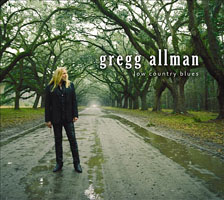Home » Jazz Articles » Album Review » Gregg Allman: Low Country Blues
Gregg Allman: Low Country Blues
But where that album was distinctly of its time, including Allman Brothers staples and other originals plus selected covers like Jackson Browne's "These Days," this Rounder release sounds timeless—almost as if it could've been recorded at the time many of its songs were originally written, back in the thirties, forties and fifties. The recording is clear and full—thanks, not just to Burnett, but to recording engineer Mike Persante and master engineer Gavin Lurssen—but the antique quality of the electric guitar and piano on "Floating Bridge," courtesy of Mac Rebennack aka Dr. John, is impossible to miss.
During the course of performing on his own and with Allman Brothers Band, Allman has often sounded like the world-weariest of singers, but he's rarely sounded as aged as he does here. Still, if it's possible to sound resolute in proportion to one's years, Allman does so here, recounting a brush with death—which is probably not all that novel an experience for this man, metaphorically and otherwise. Just to dispel the notion of a one-colored production, however, Allman belts it out on Junior Wells' "Little by Little," opening with a swell of Allman's instrument of choice, the Hammond B-3 organ, which plays a prominent role in his succinct arrangement.
Doyle Bramhall II's electric guitar rides the rhythm of that instrument, as he plays "Devil Got My Woman," while the isolated sound of Colin Linden's dobro mirrors the bleak lyrics of the Skip James' song in the sparse, quiet opening and closing sections of this track.
Not surprisingly, familiar snippets of blues poetry recur throughout the songs of Low Country Blues, as on Muddy Waters' "Can't Be Satisfied"; the words ringing true whether or not you're familiar with Allman's personal and professional history. He also sounds strong and authoritative enough to inject noticeable nuance into his phrasing on Bobby Bland's "Blind Man"—so much so that the horn section, arranged and conducted by Darrell Leonard, becomes subservient to his vocal.
The expansive instrumentation recalls Allman's early solo work, as do the background vocals on "My Love Is Your Love," but only as they hearken to his rhythm and blues influences. The sole original tune is a collaborative effort with Allman Brother/Gov't Mule leader Warren Haynes that is, perhaps not surprisingly, the sole selection with some extended instrumental work. "Just Another Rider" sits comfortably as the virtual centerpiece of a dozen tracks which, if they don't exactly redefine his style, nevertheless constitute a revelatory rediscovery of roots for Gregg Allman.
Track Listing
Floating Bridge; Little By Little; Devil Got My Woman; I Can't Be Satisfied; Blind Man; Just Another Rider; Please Accept My Love; I Believe I'll Go Back Home; Tears Tears Tears; My Love is Your Love; Checking On My Baby; Rolling Stone.
Personnel
Gregg Allman
organ, Hammond B3Gregg Allman: vocals, Hammond B-3 organ; Doyle Bramhall II: guitar; T-Bone Burnett: guitar; Vincent Esquer: guitar; Hadley Hawkensworth: guitar; Colin Linden: dobro; Mac Rebennack: piano; Dennis Crouch: acoustic bass; Jay Bellerose: drums; Darrell Leonard: bass trumpet; Tom Peterson: baritone sax; Joseph Sublett: tenor sax; Darrell Fornero: trumpet; Lester Lovitt: Trumpet; Jim Thompson: tenor sax.
Album information
Title: Low Country Blues | Year Released: 2011 | Record Label: Rounder Records
< Previous
The Da Capo Best Music Writing 2010
Comments
Tags
For the Love of Jazz
 All About Jazz has been a pillar of jazz since 1995, championing it as an art form and, more importantly, supporting the musicians who create it. Our enduring commitment has made "AAJ" one of the most culturally important websites of its kind, read by hundreds of thousands of fans, musicians and industry figures every month.
All About Jazz has been a pillar of jazz since 1995, championing it as an art form and, more importantly, supporting the musicians who create it. Our enduring commitment has made "AAJ" one of the most culturally important websites of its kind, read by hundreds of thousands of fans, musicians and industry figures every month.




















